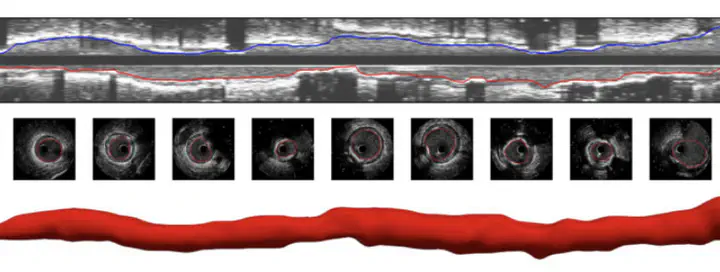Automated lumen segmentation using multi-frame convolutional neural networks in intravascular ultrasound datasets

Abstract
Aims: Assessment of minimum lumen areas in intravascular ultrasound (IVUS) pullbacks is time-consuming and demands adequately trained personnel. In this work, we introduce a novel and fully automated pipeline to segment the lumen boundary in IVUS datasets. Methods and results: First, an automated gating is applied to select end-diastolic frames and bypass saw-tooth artefacts. Second, within a machine learning (ML) environment, we automatically segment the lumen boundary using a multi-frame (MF) convolutional neural network (MFCNN). Finally, we use the theory of Gaussian processes (GPs) to regress the final lumen boundary. The dataset consisted of 85 IVUS pullbacks (52 patients). The dataset was partitioned at the pullback-level using 73 pullbacks for training (20 586 frames), 6 pullbacks for validation (1692 frames), and 6 for testing (1692 frames). The degree of overlapping, between the ground truth and ML contours, median (interquartile range, IQR) systematically increased from 0.896 (0.874–0.933) for MF1 to 0.925 (0.911–0.948) for MF11. The median (IQR) of the distance error was also reduced from 3.83 (2.94–4.98)% for MF1 to 3.02 (2.25–3.95)% for MF11-GP. The corresponding median (IQR) in the lumen area error remained between 5.49 (2.50–10.50)% for MF1 and 5.12 (2.15–9.00)% for MF11-GP. The dispersion in the relative distance and area errors consistently decreased as we increased the number of frames, and also when the GP regressor was coupled to the MFCNN output. Conclusion: These results demonstrate that the proposed ML approach is suitable to effectively segment the lumen boundary in IVUS scans, reducing the burden of costly and time-consuming manual delineation.